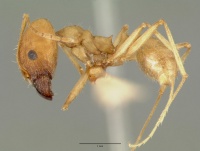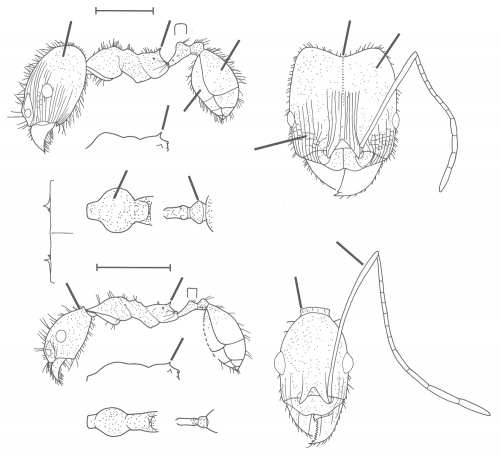Pheidole granulata
| Pheidole granulata | |
|---|---|

| |
| Scientific classification | |
| Kingdom: | Animalia |
| Phylum: | Arthropoda |
| Class: | Insecta |
| Order: | Hymenoptera |
| Family: | Formicidae |
| Subfamily: | Myrmicinae |
| Tribe: | Attini |
| Genus: | Pheidole |
| Species: | P. granulata |
| Binomial name | |
| Pheidole granulata Pergande, 1896 | |
Nothing is known about the biology of granulata.
Identification
See the description in the nomenclature section.
Keys including this Species
Distribution
Known from Baja California Sur and San Diego, California. (Wilson 2003)
Latitudinal Distribution Pattern
Latitudinal Range: 32.715° to 21.517°.
| North Temperate |
North Subtropical |
Tropical | South Subtropical |
South Temperate |
- Source: AntMaps
Distribution based on Regional Taxon Lists
Neotropical Region: Mexico (type locality).
Distribution based on AntMaps
Distribution based on AntWeb specimens
Check data from AntWeb
Countries Occupied
| Number of countries occupied by this species based on AntWiki Regional Taxon Lists. In general, fewer countries occupied indicates a narrower range, while more countries indicates a more widespread species. |

|
Estimated Abundance
| Relative abundance based on number of AntMaps records per species (this species within the purple bar). Fewer records (to the left) indicates a less abundant/encountered species while more records (to the right) indicates more abundant/encountered species. |

|
Biology
Castes
Phylogeny
 Varela-Hernández & Riquelme (2024), Fig. 3. The phylogenetic status of Pheidole praehistorica among fossil and extant congeners inferred from the list of characters (Supp. file 1: Table S1) and the data matrix (Supp. file 1: Table S2), shows the twenty-eight morphological characters to construct the most parsimonious tree. The numbers above the white and black dots represent morphological characters, and the numbers below represent the character encoding. Black dots represent synapomorphies, and white dots represent homoplasies. † represents fossil species from Dominican and Mexican amber. Consistency index = 0.52; retention index = 0.65.
Varela-Hernández & Riquelme (2024), Fig. 3. The phylogenetic status of Pheidole praehistorica among fossil and extant congeners inferred from the list of characters (Supp. file 1: Table S1) and the data matrix (Supp. file 1: Table S2), shows the twenty-eight morphological characters to construct the most parsimonious tree. The numbers above the white and black dots represent morphological characters, and the numbers below represent the character encoding. Black dots represent synapomorphies, and white dots represent homoplasies. † represents fossil species from Dominican and Mexican amber. Consistency index = 0.52; retention index = 0.65.
Nomenclature
The following information is derived from Barry Bolton's Online Catalogue of the Ants of the World.
- granulata. Pheidole (Ceratopheidole) granulata Pergande, 1896: 890 (s.) MEXICO. Combination in Ceratopheidole: Emery, 1922e: 113; in Pheidole: Kempf, 1972a: 183. See also: Wilson, 2003: 542.
Unless otherwise noted the text for the remainder of this section is reported from the publication that includes the original description.
Description
From Wilson (2003): DIAGNOSIS A member of the small granulata group, characterized by a 4-segmented antennal club, and distinguished within it as follows.
Major: entire body including all the gastral segments, foveolate and opaque; antennal scape very long, exceeding occipital comer; head subrectangular, with a deeply concave occipital border in full-face view; rugoreticulum present between each eye and antennal fossa; postpetiole from above bell-shaped.
Minor: occiput tapered into a neck with a nuchal collar; scape very long, its tip exceeding the occipital comer in full-face view by half its own length.
Overall, the habitus of this species is typical for a member of the fallax group, except for the 4-segmented club.
MEASUREMENTS (mm) Major (Burrera, Baja California Sur): HW 1.48, HL 1.74, SL 1.58, EL 0.26, PW 0.72. Minor (Burrera): HW 0.60, HL 0.92, SL 1.32, EL 0.20, PW 0.44.
COLOR Major: brownish yellow, with gaster a shade darker.
Minor: concolorous medium yellow.
Figure. Upper: major. Lower: minor. BAJA CALIFORNIA SUR, MEXICO: Burrera (col. Roy R. Snelling). Scale bars = 1 mm.
Type Material
Tepic, Nayarit, collected by Eisen and Vaslit. National Museum of Natural History - as reported in Wilson (2003)
Etymology
L granulata, of small grains, roughened on the surface, probably alluding to the foveolate body surface. (Wilson 2003)
References
- Wilson, E. O. 2003. Pheidole in the New World: A dominant, hyperdiverse ant genus. Harvard University Press, Cambridge, MA. (page 542, fig. major, minor described)
- Alatorre-Bracamontes, C.E., Vásquez-Bolaños, M. 2010. Lista comentada de las hormigas (Hymenoptera: Formicidae) del norte de México. Dugesiana 17(1): 9-36.
- Bolton, B. 1995b. A new general catalogue of the ants of the world. Cambridge, Mass.: Harvard University Press, 504 pp. (page 322, replacement name fatigata new name)
- Donisthorpe, H. 1949c [1948]. A sixth instalment of the Ross Collection of ants from New Guinea. Ann. Mag. Nat. Hist. 12(1): 744-759 (page 749, worker described)
- Emery, C. 1922c. Hymenoptera. Fam. Formicidae. Subfam. Myrmicinae. [part]. Genera Insectorum 174B: 95-206 (page 113, Combination in Ceratopheidole)
- Kempf, W. W. 1972b. Catálogo abreviado das formigas da regia~o Neotropical. Stud. Entomol. 15: 3-344 (page 183, Combination in Pheidole)
- Pergande, T. 1896. Mexican Formicidae. Proc. Calif. Acad. Sci. (2) 5: 858-896 (page 890, soldier described)
- Varela-Hernández, F., Medel-Zosayas, B., Martínez-Luque, E.O., Jones, R.W., De la Mora, A. 2020. Biodiversity in central Mexico: Assessment of ants in a convergent region. Southwestern Entomologist 454: 673-686.
- Varela-Hernández, F., Riquelme, F. 2024. Pheidole praehistorica sp. nov., a new addition to spiny ants of the genus Pheidole Westwood, 1839 (Formicidae, Myrmicinae) from Oligo–Miocene Mexican amber. European Journal of Taxonomy 968: 86-97 (doi:10.5852/ejt.2024.968.2719).
- Vázquez-Franco, C.M., Morrone, J.J. 2022. The genus Pheidole (Hymenoptera: Formicidae: Myrmicinae) in Puebla, Mexico. Revista Mexicana de Biodiversidad 93: e933820 (doi:10.22201/ib.20078706e.2022.93.3820).
References based on Global Ant Biodiversity Informatics
- Dattilo W. et al. 2019. MEXICO ANTS: incidence and abundance along the Nearctic-Neotropical interface. Ecology https://doi.org/10.1002/ecy.2944
- Fernandes, P.R. XXXX. Los hormigas del suelo en Mexico: Diversidad, distribucion e importancia (Hymenoptera: Formicidae).
- Johnson, R.A. and P.S. Ward. 2002. Biogeography and endemism of ants (Hymenoptera: Formicidae) in Baja California, Mexico: a first overview. Journal of Biogeography 29:10091026/
- Kempf, W.W. 1972. Catalago abreviado das formigas da regiao Neotropical (Hym. Formicidae) Studia Entomologica 15(1-4).
- Pergande, T. 1895. Mexican Formicidae. Proceedings of the California Academy of Sciences Ser. 2 :850-896
- Vásquez-Bolaños M. 2011. Lista de especies de hormigas (Hymenoptera: Formicidae) para México. Dugesiana 18: 95-133
- Wilson, E.O. 2003. Pheidole in the New World: A Dominant, Hyperdiverse Genus. Harvard University Press

